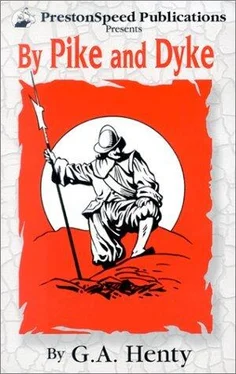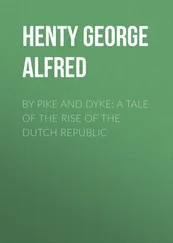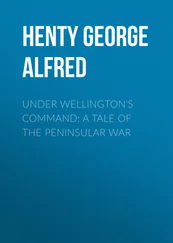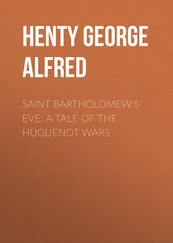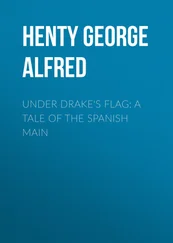G.A. Henty - By Pike and Dyke - A Tale of the Rise of the Dutch Republic
Здесь есть возможность читать онлайн «G.A. Henty - By Pike and Dyke - A Tale of the Rise of the Dutch Republic» весь текст электронной книги совершенно бесплатно (целиком полную версию без сокращений). В некоторых случаях можно слушать аудио, скачать через торрент в формате fb2 и присутствует краткое содержание. Жанр: Старинная литература, на английском языке. Описание произведения, (предисловие) а так же отзывы посетителей доступны на портале библиотеки ЛибКат.
- Название:By Pike and Dyke: A Tale of the Rise of the Dutch Republic
- Автор:
- Жанр:
- Год:неизвестен
- ISBN:нет данных
- Рейтинг книги:5 / 5. Голосов: 1
-
Избранное:Добавить в избранное
- Отзывы:
-
Ваша оценка:
- 100
- 1
- 2
- 3
- 4
- 5
By Pike and Dyke: A Tale of the Rise of the Dutch Republic: краткое содержание, описание и аннотация
Предлагаем к чтению аннотацию, описание, краткое содержание или предисловие (зависит от того, что написал сам автор книги «By Pike and Dyke: A Tale of the Rise of the Dutch Republic»). Если вы не нашли необходимую информацию о книге — напишите в комментариях, мы постараемся отыскать её.
By Pike and Dyke: A Tale of the Rise of the Dutch Republic — читать онлайн бесплатно полную книгу (весь текст) целиком
Ниже представлен текст книги, разбитый по страницам. Система сохранения места последней прочитанной страницы, позволяет с удобством читать онлайн бесплатно книгу «By Pike and Dyke: A Tale of the Rise of the Dutch Republic», без необходимости каждый раз заново искать на чём Вы остановились. Поставьте закладку, и сможете в любой момент перейти на страницу, на которой закончили чтение.
Интервал:
Закладка:
Although disgusted with their parsimony on so momentous an occasion, Gianobelli set to work with the aid of two skilful artisans of Antwerp to fit them up.
In the hold of each vessel a solid flooring of brick and mortar a foot thick was first laid down. Upon this was built a chamber of masonry forty feet long, three and a half feet wide, and as many high, and with side walls five feet thick. This chamber was covered with a roof six feet thick of tombstones placed edgeways, and was filled with a powder of Gianobelli's own invention. Above was piled a pyramid of millstones, cannonballs, chain shot, iron hooks, and heavy missiles of all kinds, and again over these were laid heavy marble slabs. The rest of the hold was filled with paving stones.
One ship was christened the Fortune, and on this the mine was to be exploded by a slow match, cut so as to explode at a calculated moment. The mine on board the Hope was to be started by a piece of clockwork, which at the appointed time was to strike fire from a flint. Planks and woodwork were piled on the decks to give to the two vessels the appearance of simple fireships. Thirty-two small craft, saturated with tar and turpentine and filled with inflammable materials, were to be sent down the river in detachments of eight every half hour, to clear away if possible the raft above the bridge and to occupy the attention of the Spaniards.
The 5th of April, the day after the capture of the Liefkenshoek, was chosen for the attempt. It began badly. Admiral Jacobzoon, who was in command, instead of sending down the fireboats in batches as arranged, sent them all off one after another, and started the two mine ships immediately afterwards. As soon as their approach was discovered, the Spaniards, who had heard vague rumours that an attack by water was meditated, at once got under arms and mustered upon the bridge and forts. Parma himself, with all his principal officers, superintended the arrangements. As the fleet of small ships approached they burst into flames. The Spaniards silently watched the approaching danger, but soon began to take heart again. Many of the boats grounded on the banks of the river before reaching their destination, others burned out and sank, while the rest drifted against the raft, but were kept from touching it by the long projecting timbers, and burned out without doing any damage.
Then came the two ships. The pilots as they neared the bridge escaped in boats, and the current carried them down, one on each side of the raft, towards the solid ends of the bridge. The Fortune came first, but grounded near the shore without touching the bridge. Just as it did so the slow match upon deck burnt out. There was a faint explosion, but no result; and Sir Ronald Yorke, the man who had handed over Zutphen, sprang on board with a party of volunteers, extinguished the fire smoldering on deck, and thrusting their spears down into the hold, endeavoured to ascertain the nature of its contents. Finding it impossible to do so they returned to the bridge.
The Spaniards were now shouting with laughter at the impotent attempt of the Antwerpers to destroy the bridge, and were watching the Hope, which was now following her consort. She passed just clear of the end of the raft, and struck the bridge close to the blockhouse at the commencement of the floating portion. A fire was smoldering on her deck, and a party of soldiers at once sprang on board to extinguish this, as their comrades had done the fire on board the Fortune. The Marquis of Richebourg, standing on the bridge, directed the operations. The Prince of Parma was standing close by, when an officer named Vega, moved by a sudden impulse, fell on his knees and implored him to leave the place, and not to risk a life so precious to Spain. Moved by the officer's entreaties Parma turned and walked along the bridge. He had just reached the entrance to the fort when a terrific explosion took place.
The clockwork of the Hope had succeeded better than the slow match in the Fortune. In an instant she disappeared, and with her the blockhouse against which she had struck, with all of its garrison, a large portion of the bridge, and all the troops stationed upon it. The ground was shaken as if by an earthquake, houses fell miles away, and the air was filled with a rain of mighty blocks of stone, some of which were afterwards found a league away. A thousand soldiers were killed in an instant, the rest were dashed to the ground, stunned and bewildered. The Marquis of Richebourg and most of Parma's best officers were killed. Parma himself lay for a long time as if dead, but presently recovered and set to work to do what he could to repair the disaster.
The Zeeland fleet were lying below, only waiting for the signal to move up to destroy the rest of the bridge and carry succour to the city; but the incompetent and cowardly Jacobzoon rowed hastily away after the explosion, and the rocket that should have summoned the Zeelanders was never sent up. Parma moved about among his troops, restoring order and confidence, and as the night went on and no assault took place he set his men to work to collect drifting timbers and spars, and make a hasty and temporary restoration, in appearance at least, of the ruined portion of the bridge.
It was not until three days afterwards that the truth that the bridge had been partially destroyed, and that the way was open, was known at Antwerp. But by this time it was too late. The Zeelanders had retired; the Spaniards had recovered their confidence, and were hard at work restoring the bridge. From time to time fresh fireships were sent down; but Parma had now established a patrol of boats, which went out to meet them and towed them to shore far above the bridge. In the weeks that followed Parma's army dwindled away from sickness brought on by starvation, anxiety, and overwork; while the people of Antwerp were preparing for an attack upon the dyke of Kowenstyn. If that could be captured and broken, Parma's bridge would be rendered useless, as the Zeeland fleet could pass up over the submerged country with aid.
Parma was well aware of the supreme importance of this dyke. He had fringed both its margins with breastworks of stakes, and had strengthened the whole body of the dyke with timber work and piles. Where it touched the great Scheldt dyke a strong fortress called the Holy Cross had been constructed under the command of Mondragon, and at the further end, in the neighbourhood of Mansfeldt's headquarters, was another fort called the Stabroek, which commanded and raked the whole dyke.
On the body of the dyke itself were three strong forts a mile apart, called St. James, St. George, and the Fort of the Palisades. Several attacks had been made from time to time, both upon the bridge and dyke, and at daybreak on the 7th of May a fleet from Lillo, under Hohenlohe, landed five hundred Zeelanders upon it between St. George's and Fort Palisade. But the fleet that was to have come out from Antwerp to his assistance never arrived; and the Zeelanders were overpowered by the fire from the two forts and the attacks of the Spaniards, and retreated, leaving four of their ships behind them, and more than a fourth of their force.
Upon the 26th of the same month the grand attack, from which the people of Antwerp hoped so much, took place. Two hundred vessels were ready. A portion of these were to come up from Zeeland, under Hohenlohe; the rest to advance from Antwerp, under Sainte Aldegonde. At two o'clock in the morning the Spanish sentinels saw four fireships approaching the dyke. They mustered reluctantly, fearing a repetition of the previous explosion, and retired to the fort. When the fireships reached the stakes protecting the dyke, they burned and exploded, but without effecting much damage. But in the meantime a swarm of vessels of various sizes were seen approaching. It was the fleet of Hohenlohe, which had been sailing and rowing from ten o'clock on the previous night.
Читать дальшеИнтервал:
Закладка:
Похожие книги на «By Pike and Dyke: A Tale of the Rise of the Dutch Republic»
Представляем Вашему вниманию похожие книги на «By Pike and Dyke: A Tale of the Rise of the Dutch Republic» списком для выбора. Мы отобрали схожую по названию и смыслу литературу в надежде предоставить читателям больше вариантов отыскать новые, интересные, ещё непрочитанные произведения.
Обсуждение, отзывы о книге «By Pike and Dyke: A Tale of the Rise of the Dutch Republic» и просто собственные мнения читателей. Оставьте ваши комментарии, напишите, что Вы думаете о произведении, его смысле или главных героях. Укажите что конкретно понравилось, а что нет, и почему Вы так считаете.
